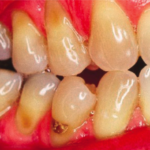
The last few UK Adult Dental Health surveys have shown that rates of edentulousness have been steadily falling. 94% of adults in England, Wales and Northern Ireland are dentate with the majority having between 27 and 32 teeth. We know that patients are keeping their teeth for longer, with time the effects of caries, restorative treatment and non-carious tooth tissue loss [NCTTL] take their toll. As rates of dental disease fall, the profession will be treating more and more patients with NCTTL. One aspect of NCTTL is the non-carious cervical lesion, [NCCL].
In an effort to understand how best to treat NCCL, a research team based in Brazil carried out a systematic review and meta-analysis comparing the performance of flowable composite vis a vis conventional resin composite in terms of marginal adaptation, marginal discolouration and retention rates when used to repair NCCL’s in adult patients.
Methods
Database searches to find were carried out using Medline, Scopus, Web of Science, LILACS, BBO, Cochrane Library and Sigle without restriction to language. Abstracts were searched from the International Association of Dental Research along with comprehensive searches of clinical trial registries and grey literature. The meta-analysis carried out by the team excluded papers judged to have a high risk of bias.
Results
- 8 RCTs were involving a total of 262 patients were included6 studies were considered to be at unclear risk of bias and 2 at high risk
- Study size ranged from 14 to 85 patients with the mean age of patient being 55.1 years of age.
- 3 studies created enamel bevels and 4 involved roughening of the dentine.
- No study followed patients up for more than 3 years.
- No statistically significant differences were detected between flowable and resin composites in terms of loss of retention or for marginal discolouration in any recall period.
- There was a significant difference in favour of the marginal adaptation of flowable composite at 1 and 3 years.
- The authors argue that this is a result of flowable composite achieving better wetting of the tooth substrate and therefore achieving better marginal adaptation.
Conclusions
The authors conclude: –
that the viscosity of the restorative material had no effect on loss of retention or marginal discolouration but flowable composites do have improved marginal adaptation at 1 and 3 years.
Comments
The paper used a methodologically sound search strategy with clearly described inclusion and exclusion criteria. Studies were included if they were a randomised control trial with a minimum follow up of 1 year. Risk of bias was assessed using the Cochrane Risk of Bias Tool and the quality of the studies assessed using the Cochrane GRADE methodology. The paper sought to address a common clinical problem, loss of retention of class 5 restorations and the best way to treat them. The use of low elastic modulus materials was advocated in order to overcome the increased compression and expansion that these restorations experience. It was argued that the use of flowable materials would overcome the tendency for resin composite to dislodge or lose marginal integrity. Initial studies using these low elastic modulus materials tended to use filled adhesives or thicker layers of unfilled adhesives.
This study has attempted to evaluate the success of using flowable composite with their higher filler content than filled adhesives but lower filler than conventional resin restorations. This study found that in terms of retention and marginal discolouration there was no difference between flowable and resin composites.
Within the included studies, there are a variety of bonding strategies from self-etch adhesives to etch and bond systems. Given the small number of included studies, the research group were not able to examine the effect of the bonding strategy on the clinical success of the restorations. Future research examining the difference in flowable and resin composite success rates but using a standardised bonding system would be useful.
Links
Primary Paper
Szesz A, Parreiras S, Martini E, Reis A, Loguercio A. Effect of flowable composites on the clinical performance of non-carious cervical lesions: A systematic review and meta-analysis. J Dent. 2017 Oct;65:11-21. doi:10.1016/j.jdent.2017.07.007. Epub 2017 Jul 17. Review. PubMed PMID: 28729119.
Other references
Adult Dental Health Survey, 2009.
Dental Elf – 15th Aug 2014
Review suggests that glass ionomers had best retention rates in non-carious cervical lesions
Dental Elf – 11th May 2015
Picture Credits
By John O. Grippo Marvin Simring Thomas A. Coleman [CC BY-SA 4.0 ], via Wikimedia Commons

[…] post Flowable composites: clinical performance in non-carious cervical lesions appeared first on National Elf […]